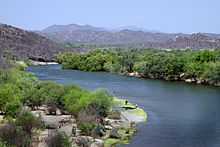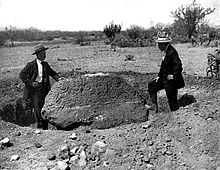Yaqui River

The Yaqui River (Río Yaqui in Spanish) (Hiak Vatwe in the Yaqui or Yoeme language) is a river in the state of Sonora in northwestern Mexico. Being the largest river system in the state of Sonora, the Yaqui river is used for irrigation.
Approximately 320 km (200 mi) in length, the Rio Yaqui flows south and southwest to empty into the Gulf of California.
The Rio Yaqui originates in the Sierra Madre Occidental and flows into the Gulf of California near the city of Obregon.
Its course is interrupted by several reservoirs like Plutarco Elías Calles (El Novillo), Lázaro Cárdenas (Angostura), or Álvaro Obregón (El Oviáchic, Lake Ouiachic), which provides the water resource for the intensively irrigated region of Ciudad Obregón.
Human history

In the early 1900s, after a series of conflicts with the Mexican Army, most of the remaining Yaqui were arrested and dispersed to plantations in the Yucatán Peninsula. The survivors continued resisting until the late 1920s, when Mexican authorities overcame resistance by employing heavy artillery and aircraft to bomb and shell Yaqui villages.
Also in the early 1900s, Major Frederick Russell Burnham, the celebrated American scout, went to Mexico in search of minerals resources. While there he met the naturalist Dr. Charles Frederick Holder and the two men soon became associated with the early Yaqui River irrigation project. Burnham reasoned that a dam could provide year-round water to rich alluvial soil in the valley; turning the region into one of the garden spots of the world and generate much needed electricity. He purchased water rights and some 300 acres (1.2 km2) of land in this region and contacted an old friend from Africa, John Hays Hammond, who conducted his own studies and then purchased an additional 900,000 acres (3,600 km2) of this land—an area the size of Rhode Island. He became a close business associate of Hammond and led a team of 500 men in guarding mining properties owned by Hammond, J.P. Morgan, and the Guggenheims in the Mexican state of Sonora.[1] Just as the irrigation and mining projects were nearing completion in 1912, a long series of Mexican revolutions began. The final blow to these efforts came in 1917 when Mexico passed laws prohibiting the sale of land to foreigners. Burnham and Hammond carried their properties until 1930 and then sold them to the Mexican government.[2]
Burnham together with Holder made important archeological discoveries of Mayan civilization in this region, including the Esperanza Stone.[3][4] In his book, The Book of the Damned, Charles Forte would use this stone as proof that aliens from outer space had been on Earth. The supernatural nature of this stone would be perpetuated by many other authors in several subsequent books on anomalistics.
Ecology
The Rio Yaqui was once home to the American crocodile (Crocodylus acutus) and represented one of the northernmost natural locations for the species. Decades of environmental degradation in the region led to the extirpation of the species from the region.[5]
See also
References
Bibliography
- Fort, Charles; Liveright, Horace (1919). The Book of the Damned. Horace Liveright. chap. XI. ISBN 978-1-870870-53-5.
- Hammond, John Hays (1935). The Autobiography of John Hays Hammond. New York: Farrar & Rinehart. ISBN 978-0-405-05913-1.
- "Guarding Morgan Mines: Burnham's Force also at Guggenheim Properties is report" (PDF). The New York Times. April 23, 1912. ISSN 0362-4331. Retrieved September 28, 2007.
- Holder, Charles (1910). "The Esperanza Stone". Scientific American: 196.
External links
- The Yaqui River Drainage, Americas Heritage Waters, Northern Arizona University
- Cuenca Los Ojos Foundation